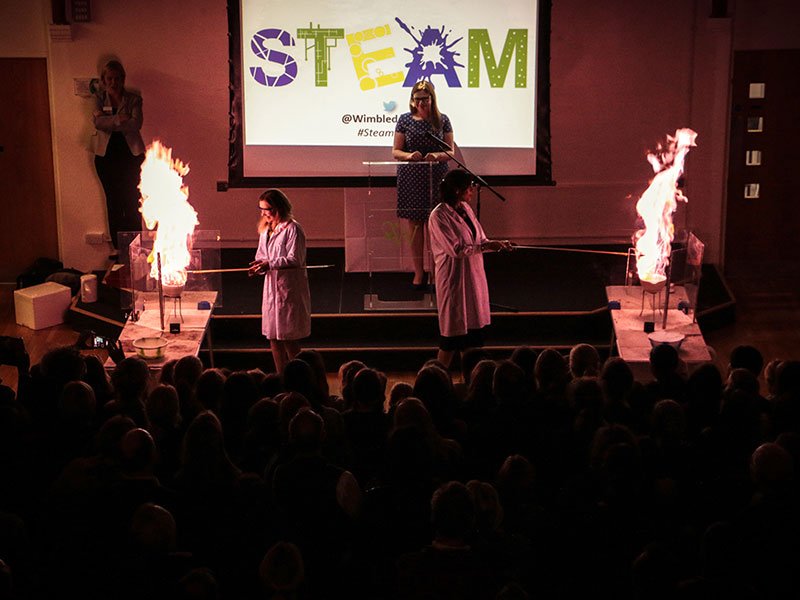Blog
Connecting in an age of connectivity
Image caption: The launch of the Wimbledon High School’s STEAM room happened with a bang. Jane Lunnon, lighting the flame on the right with Edith Goakes, Head of Physics and in charge of STEAM on the left and with guest speaker Dr Christie Marr, Director at the Isaac Newton Institute for Mathematical Sciences, Cambridge.
“Only connect”. This famous exhortation from Forster’s Howard’s End, exhorts us to “connect the prose and the passion … to live in fragments no longer”. Writing in 1910, Forster was alarmed by an increasingly alien, rapidly industrialising world which seemed to threaten the very business of being human and being alive. His reflection on the changes to transport in the same novel, makes this clear: “month by month the roads smelt more strongly of petrol, and were more difficult to cross, … human beings heard each other speak with greater difficulty, breathed less of the air, and saw less of the sky….”
Here we are again, not far from the start of another century and certainly in the grip of another technological revolution (“the fourth revolution” by all accounts), wrestling with the explosive impact of digital innovation and what it means for us all, in the way we live, the way we think and the way we connect with our world and with each other. The irony of this particular revolution is, at least on the surface, it seems to be all about connection. Snapchat, Instagram, Whatsapp, Facebook, twitter and all the rest, connect us at light speed with the whole world. As long as we both have internet access, I can talk instantaneously by video or text with anyone at any time of day in any part of the world. What a miraculous thing for our species to have achieved. Truly a kind of magic; the world wide web connecting us like never before.
But, Forster, like most great artists, invites us to think about what deep connection really means and what can be gained by properly engaging with what really matters. Nowhere is this discussion more important than in schools and it is one we have been having in a whole host of ways at Wimbledon High. We’ve been thinking this year about how academic subjects connect, thinking beyond the “fragments” of what were in essence 19th century constructs (let’s call this Biology, let’s put this into Geography, let’s make this History and this Classics) and instead exploring what can be gained when learning is properly cross-curricular and inter-disciplinary.
Never, in my view, has it been more critical to join the “prose” with the “passion” – and to think about how best we can do that in our approach to the subjects we teach in school. Arts education is seriously under threat in this country. With the national focus on the ebacc (no requirement for arts subjects to be an examined part of the KS4 curriculum), with government cuts in funding and therefore monumental pressure on state school budgets, with an increased (and entirely laudable) emphasis on STEM learning and with a growing shortage of teacher supply, we are sleepwalking, nationally into a cultural vandalism which will leave us all utterly impoverished. If Music, Drama, Art and Dance are marginalised in our schools, if our children are not, routinely being taught when they are young about the wonders of Mozart, Da Vinci, Pinter and Balanchine, then who will care, defend, talk about, understand, visit, or promote the Arts in future years? More importantly, what will the furniture of our children’s minds be made up of? What will replace this kind of learning and knowledge? Youtube? Vines? Meme-culture: “It’s Wednesday my dudes….aaaaaaaah” / “Oh you don’t understand, let me explain it again, the exact same way”…
This is not an argument for some kind of middle-class elite long-dead world. Arts education (based on historic knowledge of what has gone before and a delight in experimental, current self-expression) is not some nice to have extra on the side. It is utterly integral to who we are. How have we lost sight of this? This is an argument for humanity. As human beings, we painted on cave walls whilst we were learning to make weapons out of stones. Prose and passion. Arts and tech. We have always found voice, meaning and an essential outlet for our hearts and our imaginations in artistic expression and it is deeply concerning that short term budgetary constraints or the expediencies of a capitalist, market-driven economy, is driving artistic experience in our children to the margins in this way.
None of this is to deny the necessity of excellent teaching in the rest of the curriculum. I have written before about the shocking national shortage of girls and women studying STEM subjects in this country for example. This needs addressing and I applaud the government for trying to do so. But it should not be at the expense of those subjects which apparently will have less immediate commercial value when our children become employees and tax-payers. What kind of robotic, soul-less, money-grubbing, technical world do we want to live in? And (critically) what kind of people do we want our children to become? Must one kind of learning be sacrificed for another?
Well, no. Not necessarily. In this, as in so many things, I feel Forster had it right… only connect. We can find ways of meeting both the needs of a 21st century jobs market, with its emphasis on technical assurance, resilience, problem-solving, intellectual agility and creativity by taking a less categorised and more fluid approach to learning – especially at the critical 11 – 15 age range. The secret is to stop thinking in subject boxes – to break down the borders between subjects and to think, instead, about the fascinating ways in which they might connect. We’ve made a start with that this year, in our prototype STEAM room, staffed by three wonderful scientists in residence. In it, we’ve run many collaborations over recent months: students studying how post-traumatic stress disorder could have influenced the World War 1 poets, Geographers having a go at designing a wind turbine, musicians looking at the physics of music, artists inspired by biological dissection, the creation of the dyes which might have been used to make Joseph’s technicolour dreamcoat and so on. The possibilities for this kind of connected approach are endless and deeply exciting and all our Heads of Department have been asked to build it into their schemes of work next year.
Of course, until the government radically re-thinks national assessment at GCSE (and playing about with numbers instead of grades isn’t really what I mean), we can’t lose the subject silos completely. And actually, nor would we want to. The pleasure of deep absorption in a specific subject area is a critical part of growing up and is another way of ensuring scholarship, academic rigour and a close connection with learning. But, the inter-disciplinary approach can enhance and develop understanding of and engagement with one particular subject in the most exciting ways. We have found our students’ tendency to remember, retain and reproduce key information (necessary for assessment) is enhanced by a STEAM approach. Consider what the impact is, when an art teacher takes their class into a biology lab, to look closely at the dissected heart. The biology teacher talks through the technical processes: “here is the vena cava, here are the four chambers of the heart, the left ventricle is this colour and this thickness because it pumps the hardest…” and so on. The children are scrutinising and learning and making connections – and THEN they paint – responding artistically to what is in front of them, in any way they choose. They are not drawing a diagram – because this is art – not science – but it’s wonderful to see how scientific understanding can inspire or refine or provoke their artistic responses.
It seems to me, if we are to meet the demands of a rapidly changing and highly technical workplace, if we are to ensure that our children develop and retain the sensitivity, heart and cultural understanding which the Arts provide and if we are to find ways of flourishing in our new world and our new century – rejecting fragmented, isolated learning and connecting the prose and the passion in as many ways as we possibly can, is not only a good idea, it’s an absolutely essential one.
Jane Lunnon, Head, Wimbledon High School GDST



